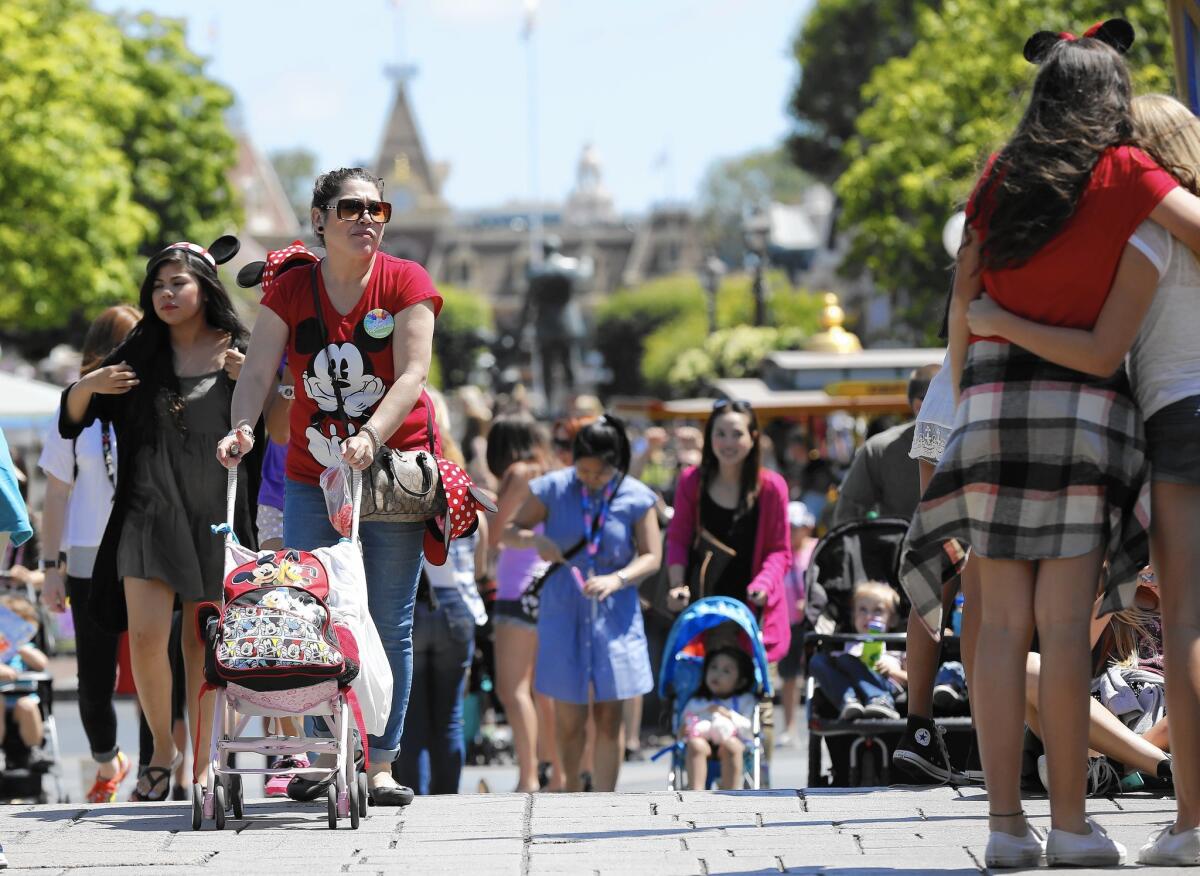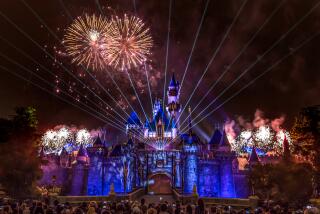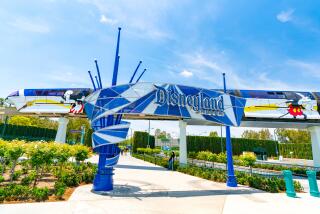Variable pricing may be a new theme at Disneyland

Walt Disney Co. is actively looking at “variable” pricing for Disneyland, a system in which prices would rise during periods of high demand. Above, parkgoers walk along Main Street in May 2014.
- Share via
When Disneyland raised prices for its most expensive annual pass this past weekend to more than $1,000, hard-core parkgoers groaned.
Even so, throngs are still expected to fork over cash for the passes or buy daily tickets to converge on the popular Anaheim theme park, which last Christmas had to temporarily turn away visitors.
“Disney has a problem with excess demand,” said Martin Lewison, a theme park expert and business management professor at Farmingdale State College in New York. “The park has a limited capacity. They have to close the gates on busy days. Nobody wants to do that.”
And there is not much Disney can do about it because the 160-acre resort is hemmed in by freeways and roads and cannot expand its footprint.
The solution?
Walt Disney Co. is actively looking at so-called variable pricing — with prices rising during high demand. Uber uses a more extreme version called “dynamic” pricing, which can raise prices instantaneously based on real-time demand during, say, a Saturday night.
Disney is “getting ahead of the curve on pricing,” said Dennis Speigel, president of International Theme Park Services in Cincinnati, noting that hotels change their room prices based on demand.
In fact, Walt Disney Resorts sent out an online survey of annual pass holders in May, asking their opinion of a three-tiered pricing system aimed at charging higher prices during Christmas, spring break and summer.
“We continue to evolve the way we think about managing demand — particularly during our busiest seasons — in order to deliver a world-class experience for our guests,” said park spokeswoman Suzi Brown, adding that the company is “exploring pricing options that could help spread out visitation throughout the year.”
Lewison said the efforts to spread out the attendance could ease frustration from regular visitors about long lines and shoulder-to-shoulder crowds.
“When you get into the park and it’s wall-to-wall people, it really degrades the guest experience,” Lewison said. “You want to push off the crowds to the nonpeak days.”
U.S. theme parks have yet to adopt the strategy on a widespread basis, he added. But Disneyland Paris already employs a form of variable pricing. For example, a single daily adult ticket to both Disneyland Park and Walt Disney Studios Park valid for one year costs $101, while a ticket with restricted dates costs $85.
Dominique Hanssens, a professor of marketing and a pricing expert at the UCLA Anderson School of Management, said that dynamic pricing and variable pricing have become commonplace in many industries, including airlines.
He said companies must rely heavily on survey results as well as other data to determine the “price elasticity” for their products, such as Disney’s annual pass, so they can gauge the highest price they can charge before visitors revolt.
“Since they raised the price, they have good data base on how the public will react to the price changes,” he said.
SIGN UP for the free California Inc. business newsletter >>
Disney has not said when and whether it will adopt variable pricing, but this much is certain: The latest annual pass price increases were designed to make passes that offer access to the parks during peak holiday periods more expensive.
But that is not going over well with some fans, who note that such price hikes typically have come at the beginning of the busy summer season or just before the launch of a new attraction.
Instead, the latest boost comes only eight months after the last increase and only three months before several attractions are scheduled to close to make way for the much-anticipated opening of Star Wars Land several years from now.
Disneyland increased prices for daily passes in February, to $99 from $96 to enter one park, and to $155 from $150 for a two-park ticket, including California Adventure. The premium annual pass with no blackout dates jumped to $779 from $699 for both parks.
“From the outside it looks strange: You are offering me less and charging me more,” said David Koenig, the author of several books about Disney.
Disneyland plans to permanently close Big Thunder Ranch Barbecue, Big Thunder Ranch Petting Zoo and Big Thunder Ranch Jamboree. Several other attractions, including the Disneyland Railroad, will close temporarily during construction.
Starting Nov. 16, the park plans to upgrade existing rides in Tomorrowland to promote the release of the film “Star Wars: The Force Awakens.” But no major new attractions are expected until the opening of the 14-acre Star Wars Land sometime in the next few years.
The price increases, which were announced and went into effect Sunday, raise the price of an annual pass to both parks with no blackout dates by 35% to $1,049.
The Signature Plus pass lets guests visit the two Anaheim parks any day of the year and includes free parking, food and merchandise discounts and unlimited digital downloads of the photos taken through the PhotoPass program. It replaces a Premium pass that cost $779, including parking.
Disney added a new Signature pass that blacks out the most popular days — Dec. 19 to Jan. 2 — and includes parking and food and merchandise discounts, plus the digital downloads, for $849.
Disney also announced new higher annual pass prices for the Magic Kingdom in Florida, with the most expensive pass selling for $829, up from $779.
Still, despite grousing by some Disney fans, industry experts say attendance numbers should continue to rise.
Disney does not disclose attendance numbers, but the company reported the park reached record attendance and profits in the period from April to June.
The Los Angeles engineering firm Aecom estimated that attendance at the park grew 3.5% in 2014 to 16.7 million visitors, making it the third-most-visited theme park in the world behind leader Magic Kingdom at Walt Disney World and No. 2 Tokyo Disney.
Disneyland officials declined to disclose how many annual passes they have sold, but they said that, on average, annual pass holders visit the park more than 10 times a year.
Daniel Bowen of Sylmar has owned a Disneyland premium pass for 24 years and visits at least twice a week. Despite the price increase, he said he will buy the Signature Plus pass without blackouts because he enjoys visiting the park on New Year’s Day.
Disney’s shares closed up 85 cents, or nearly 1%, to $103.85 on Monday.
Twitter: @hugomartin
ALSO
American Apparel files for bankruptcy but may need to do more to survive
Lionsgate and Starz in advanced merger talks, sources say
Seeking a competitive edge in sports via IBM Watson
More to Read
Inside the business of entertainment
The Wide Shot brings you news, analysis and insights on everything from streaming wars to production — and what it all means for the future.
You may occasionally receive promotional content from the Los Angeles Times.











